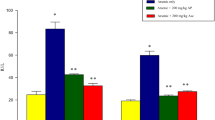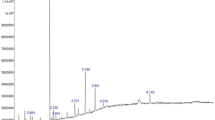Abstract
In this experimental study, we investigated whether l-ascorbic acid has any influence on the blood antioxidant defense system, lipid peroxidation and hematological parameters of the albino rats exposed to nickel sulfate(NiSO4).Twenty four adult rats were divided into four groups of six animals in each group. The control rats were untreated and comprised Group I. Group II rats were administered nickel sulfate (2.0 mg/100 g b.wt.; intraperitonially, i.p.). Group II rats were treated orally l-ascorbic acid (50 mg/100 g b.wt.) and Group IV rats were given both nickel sulfate and l-ascorbic acid simultaneously on alternate days until the tenth dose. The hematological parameters were assessed: red blood corpuscle counts, packed cell volume %, hemoglobin concentration, white blood corpuscle counts and platelets count decreased significantly and clotting time increased significantly in nickel treated rats. We also observed increase malondialdehyde (MDA) and decrease glutathione level (GSH) in erythrocytes of nickel treated rats. The activities of erythrocyte antioxidant enzymes like superoxide dismutase (SOD), glutathione peroxidase (GSH-Px) and catalase (CAT) were significantly increased in rats treated with nickel sulfate. Simultaneously treatment of l-ascorbic acid exhibited a possible protective role on the toxic effect of nickel sulfate on the hematological values, erythrocyte MDA and GSH concentrations as well as antioxidant enzymatic defense system.
Similar content being viewed by others
References
Aebi H (1974) Catalase. In: Bergmeyer HU (ed) Methods of Enzymatic Analyses. Weinheim, Verlag Chemie, pp 673 – 684
Agency for Toxic Substances and Disease Registry (ATSDR). 2003 Toxicological profile for nickel, US department of Health and Human Services, Public Health Service, ATSDR. Atlanta, Georgia, USA: US Government Printing
Ambrose AM, Larson PS, Boezelleca JF et al 1976 Long term toxicologic assessment of nickel in rats and dogs. J Food Sci Technol 13, 181–187
Beutler E, Duron O, Kelly BM (1963) Improved method for the determination of blood glutathione. J Lab Clin Med 61:882–888
Bordes E, Papillion VV (1983) Myocardial change induced by nickel and in association with cadmium. Rev Ig Bacteriol Virusal Parazitol Epidemol Pneumotizol 32:51–56
Brucka-Jastrz E, Bska M, Protas-Owicki A (2005) Effects of cadmium and nickel exposure on hematological parameters of common carp, Cyprinus carpio L. ACTA Ichthyologica et piscatora 35(1):29–38
Costa M, Klein CB (1999) Nickel carcinogenesis mutation, epigenetics,or selection. Environ Health Perspect 107(9):A438-A439
Das KK, Dasgupta S (1997) Alteration of testicular biochemistry during protein restriction in nickel treated rats. Biol Trace Elem Res 60:243–248
Das KK, Dasgupta S (1998) Studies on the role of nickel in the metabolism of ascorbic acid and cholesterol in experimental animals. Ind J Physiol Allied Sci 52:58–62
Das KK, Dasgupta S (2000) Effect of nickel on testicular nucleic acid concentrations of rats on protein restriction. Biol Trace Elem Res 73:175–180
Das KK, Das SN, Dasgupta S (2001) The influence of ascorbic acid on nickel induced hepatic lipid peroxidation in rats. J Basic Clin Physiol Pharmacol 12:187- 194
Das KK, Dasgupta S (2002) Effect of nickel sulfate on testicular steroidogenesis in rats during protein restriction. Environ Health Perspect 110: 923–926
Das KK, Das SN (2004) Studies on the role of ascorbic acid on nickel induced hepatic nucleic acid concentrations in rats. J Basic Clin Physiol Pharmacol 14(3–4):185–195
Das KK, Das Gupta A, Dhundasi SA, Patil AM, Das SN, Ambekar JG (2006) Effect of l-ascorbic acid on nickel-induced alteration in serum lipid profiles and liver histopathology in rats. J Basic Clin Physiol Pharmacol 17(1):29–44
Declaration of Helsinki (1964) 1996 Amended by World Medical Assembly, Venice, Italy, 1983. Br Med J 313(70):1448–1449
Doreswamy K, Balakrishna S, Thimappa R, Muralidhara (2004) Nickel-induced oxidative stress in testis of mice: evidence of DNA damage and genotoxic effects. J Androl 25:996–1003
Dunnick JK, Elwell MR, Radovsky AE et al (1995) Comparative carcinogenic effects of nickel subsulfide, nickel oxide, or nickel sulfate chronic exposure in the lung. Cancer Res 55:5251–5256
Edes I, Piros G, Toth GK, Csanady M, Kovacs K (1986) Effect of long term alcohol ingestion on glutathione metabolizing enzymes and taurine content in the myocardium of rats. Cardiovasc.Res 20:918–921
Ercal N, Gurer O, Aykin-Burns N (2001) Toxic metals and oxidative stress part 1: mechanisms involved in metal induced oxidative damage. Curr Top Med Chem 1:529–539
Garcia-Mazano A, Gonzalez-Llaven J, Lemini C et al (2001) Standardization of rat blood clotting tests with reagent used for humans. Proc West Pharmacol Soc 44:153 – 155
Gowenlock AH (1996) Varley’s practical clinical biochemistry, 6th edition (Indian reprint). New Delhi, CBS Publishers
Gutteridge JMC(1993) Free radicals in disease processes: a complication of cause and consequence. Free Radic Res Commun 19:141–158
Halliwell B, Gutteridge JMC (1984) Lipid peroxidation, oxygen radicals, cell damage, and antioxidant therapy. Lancet 1:1396-1397
Halliwell B, Gutteridge JMC (1986) Oxygen free radicals and iron in relation to biology and medicine: some problem and concepts. Arch Biochem Biophys 246:501-514
Hussain KH, Sugenetran K, Pant SC et al (1992) Biochemical and pathological change in response to hypoxic and protection by antioxidant in rats. Indian J Physiol Pharmacol 36:51–56
Kalinih JF, Emond CA, Dalton TK et al (2005) Embedded weapons grade tungsten alloy shrapnel rapidly induces metastasis high grade rhabdomyo-sarcomas in F344 rats. Env Health Perspect 113(6):729 – 734
Kanungo MS, Patnaik BK (1964) Ascorbic acid and ageing in the ratio: uptake of ascorbic acid by skin and bone marrow, and its concentration in various organs. Biochem J 90:637
Kelle M, Diken H, Sermet AR, Atmaca M, Tomer C (1999) Effect of exercise on blood antioxidant status and erythrocute lipid peroxidation: Role of dietery supplementation of vitamin E. Tr J Med Sci 29:95–100
Kei S (1978) Serum lipid peroxide in cerebrovascular disorders determined by a new colorimetric method. Clin Chem Acta 90:37–43
Kupferschmidt H. 2001 (May 16–19) Features and management of nickel intoxication. In: XXI international congress of the EAPCCT. Barcelona
Kurata M, Suzuki M, Agar NS (1993) Antioxidant systems and erythrocytes life-span in mammals. Comp Biochem Physiol B 106:477–487
Mates JM (2000) Effect of antioxidants enzymes in the molecular control of reactive oxygen species. Toxicology 153:83–104
Merchant MA, Mod DN (2004) Acute and chronic effects of aspirin on hematological parameters and hepatic ferritin expression in mice. Indian J Pharmacol 36(4):226–230
Misra HP, Fridovich I (1972) The role of superoxide anion in the autooxidation of epinephrine and simple assay for superoxide dismutase. J Bio Chem 247:3170–3175
Nakababu E, Chrest FJ, Rifkind JM (2003) Hydrogen peroxide induced heme degradation in red blood cell: the protective roles of catalase and glutathione peroxidase. Biochem Biophys Acta 1620:211–217
Nielsen FH, Shuler TR, Mcleod TG, Zimmerman TJ (1984) Nickel influences iron metabolism through physiologic, pharmacologic and toxicologic mechanisms in rats. J Nutr 114:1280–1288
Nieboer E, Nriagu JO. 1988 In: Advances in environmental sciences and technology. New York: Wiley and sons: 25
Ochi T, Otsuka T, Oshawa M (1988) Glutathione and metallothioneins as cellular defense against cadmium toxicity in cultured Chinese hamster cell. Chem Biol Interact 65:1–14
Onkelinx C, Becker J, Sunderman FW Jr (1973) Compartmental analysis of the metabolism of Ni (II) in rats and rabbits. Res Commun Chem Pathol Pharmacol 6:663
Paglia DE, Valentine WN (1967) Studies on the quantitative and qualitative characterization of erythrocyte glutathione peroxidase. J Lab Clin Med 70(1):158–169
Sagun KC, Carcamo JM, Golde DW (2005) Vitamin C enters mitochondria via facilitative glucose transporter 1(glut-1) and confers mitochondrial protection against oxidative injury. FASEB J 19(2):1657–1667
Salnikow K, Donald SP, Bruick RK, Zhitkovich A, Phang JM, Kasprzak KS (2004) Depletion of intracellular ascorbate by the carcinogenic metal nickel and cobalt results in the induction of hypoxic stress. J Biol Chem 279:40337–40344
Sarkar S, Yadav P, Trivedi R, Bansal AK, Bhatnagar D (1995) Cadmium-induced lipid peroxidation and the status of antioxidant system in rat tissues. J Trace Elem Med Biol 9:144–149
Sarkar S, Yadav P, Trivedi R, Bansal AK, Bhatnagar D (1998) Lipid peroxidative damage on cadmium exposure and alterations in antioxidant system in rat erythrocytes: a study with relation to time. Bimetals 11: 153–155
Scansetti G, Maina G, Botta GC et al (1998) Exposure to cobalt and nickel in the hard metal production industry. Int Arch Occup Environ Health 71(1):60–63
Shaikh ZA, Vu TT, Zaman K (1999) Oxidative stress as a mechanism of chronic cadmium induced hepatotoxicity and renal toxicity and protection by antioxidants. Toxicol Appl Pharmacol 15:256–263
Shi H, Noguchi N, Niki E (1999) Comparative study on dynamics of antioxidative action of ∞-tocopheryl hydroquinone, ubiquinol and α-tocopherol against lipid peroxidation. Free Radic Biol Med 27:334-346
Shivarajashankara YM, Shivashankara AR, Gopalkrishna PB, Hanumanth Rao S (2001) Effect of fluoride intoxications on lipid peroxidation and antioxidant systems in rats. Floride 34(2):108–113
Steel RGD, Torrie JH. 1960 In: Principles and procedures of statistics. New York: McGraw-Hill: 99–131
Tkeshelashvili LK, Tsakadze KZ, Khulissairio V (1989) Effect of some nickel compounds on red blood cell characteristics. Biol Trace Elem Res 21:337–342
US NIOSH/OSHA.1985 Pocket guide to chemical hazards, Wahington DC, US National Institute of Occupational Safety and Health, Occupational Safety and Health Administration (Publication No. 85.114)
USAT. 1990 Nickel. In: Installation, restoration programme toxicology guide. Marry G. Armstrong Aerospace Medical Research Laboratory. OH: Wright Patterson AFB: Vol 5
Vest RS, Gonzales LL,Permann SA, Spencer E,Hamsen LD,Judd AM, Bell JD (2004) Divalent cations increase lipid order in erythrocytes and susceptibility to secretary phospholipids A2. Biophys J 86:2251–2260
Whanger PD (1973) Effects of dietary nickel on enzyme activities and mineral content in rats. Toxicol Appl Pharmacol 26:323–331
Acknowledgements
The authors greatly acknowledge Director, Defence Institute of Physiology and Allied Sciences, Delhi, DRDO, Ministry of Defence, Government of India for providing financial assistance (Ref.No.TC/260/TASK-91 (KKD)/DIPAS/2004 Dated 07/06/2004) to carry out this work. The authors also acknowledge the Dr. B.S. Patil, Dean of Al-Ameen Medical College, Bijapur for his kind cooperation and Mr. Saleem Pathan, Animal House Incharge and Mr. Abid Jahagirdar, Computer operator, Al-Ameen Medical College, Bijapur, Karnataka, India for their technical assistance in this study.
Author information
Authors and Affiliations
Corresponding author
Rights and permissions
About this article
Cite this article
Das, K.K., Gupta, A.D., Dhundasi, S.A. et al. Protective role of l-ascorbic acid on antioxidant defense system in erythrocytes of albino rats exposed to nickel sulfate. Biometals 20, 177–184 (2007). https://doi.org/10.1007/s10534-006-9025-z
Received:
Accepted:
Published:
Issue Date:
DOI: https://doi.org/10.1007/s10534-006-9025-z




